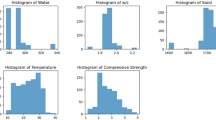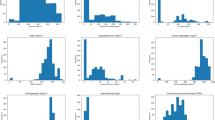Abstract
The uniaxial compressive strength of rock is one of the most significant parameters required for analysis of rock mass, its characterization, and design of foundations. Direct determination of the uniaxial compressive strength of rock is time-consuming, expensive, and requires destructive laboratory or field testing. Therefore, indirect methods based on regression analysis are widely used for estimation of the uniaxial compressive strength of rock, which have less accuracy. In this study, machine learning algorithms are used to estimate the uniaxial compressive strength of rock using point load strength, porosity, Schmidt rebound hardness, block punch index, and specific gravity. The performance of each machine learning model is evaluated using statistical parameters, viz., mean absolute error, value account for, and coefficient of determination. It is found that random forest regression is the most suitable model for estimation of uniaxial compressive strength with the minimum mean absolute error of 8.68 MPa and r2-score of 0.94.






















Similar content being viewed by others
References
E. Hoek, C. Carranza-Torres, B. Corkum, Hoek-Brown failure criterion-2002 edition. Proc. NARMS-Tac 1(1), 267–273 (2002)
B. Adebayo, A. E. Aladejare, Effect of rock properties on excavation-loading operation in selected quarries, in Advanced materials research, vol. 824. (Trans Tech Publications Ltd, 2013)
R. Ulusay, The ISRM suggested methods for rock characterization, testing and monitoring: 2007–2014 (Springer, Berlin, 2014)
V. Palchik, Use of stress–strain model based on Haldane’s distribution function for prediction of elastic modulus. Int. J. Rock Mech. Min. Sci. 44(4), 514–524 (2007)
D.A. Mishra, A. Basu, Estimation of uniaxial compressive strength of rock materials by index tests using regression analysis and fuzzy inference system. Eng. Geol. 160, 54–68 (2013)
Y. Wang, A.E. Aladejare, Selection of site-specific regression model for characterization of uniaxial compressive strength of rock. Int. J. Rock Mech. Min. Sci. 75, 73–81 (2015)
A. Aydin, A. Basu, The Schmidt hammer in rock material characterization. Eng. Geol. 81(1), 1–14 (2005)
S. Kahraman, O. Gunaydin, The effect of rock classes on the relation between uniaxial compressive strength and point load index. Bull. Eng. Geol. Environ. 68(3), 345–353 (2009)
A. Basu, M. Kamran, Point load test on schistose rocks and its applicability in predicting uniaxial compressive strength. Int. J. Rock Mech. Min. Sci. 47(5), 823–828 (2010)
M.M. Aliyu et al., Assessing the uniaxial compressive strength of extremely hard cryptocrystalline flint. Int. J. Rock Mech. Min. Sci. 113, 310–321 (2019)
A.E. Aladejare, Evaluation of empirical estimation of uniaxial compressive strength of rock using measurements from index and physical tests. J. Rock Mech. Geotech. Eng. 12(2), 256–268 (2020)
Y.M. Li, G.F. Zhao, A numerical integrated approach for the estimation of the uniaxial compression strength of rock from point load tests. Int. J. Rock Mech. Min. Sci. 148, 104939 (2021)
F. Huang, J. Shen, M. Cai, C. Xu, An empirical UCS model for anisotropic blocky rock masses. Rock Mech. Rock Eng. 52(9), 3119–3131 (2019)
D. Gupta, N. Natarajan, Prediction of uniaxial compressive strength of rock samples using density weighted least squares twin support vector regression. Neural Comput. Appl. 33(22), 15843–15850 (2021)
F. Meulenkamp, M.A. Grima, Application of neural networks for the prediction of the uniaxial compressive strength (UCS) from Equotip hardness. Int. J. Rock Mech. Min. Sci. 36(1), 29–39 (1999)
B. Tiryaki, Predicting intact rock strength for mechanical excavation using multivariate statistics, artificial neural networks, and regression trees. Eng. Geol. 99(1–2), 51–60 (2008)
K. Zorlu et al., Prediction of uniaxial compressive strength of sandstones using petrography-based models. Eng. Geol. 96(3–4), 141–158 (2008)
S. Dehghan et al., Prediction of uniaxial compressive strength and modulus of elasticity for Travertine samples using regression and artificial neural networks. Min. Sci. Technol. (China) 20(1), 41–46 (2010)
A. Cevik et al., Modeling of the uniaxial compressive strength of some clay-bearing rocks using neural network. Appl. Soft Comput. 11(2), 2587–2594 (2011)
D. Jahed Armaghani, V. Safari, A. Fahimifar, M. Monjezi, M.A. Mohammadi, Uniaxial compressive strength prediction through a new technique based on gene expression programming. Neural Comput. Appl. 30(11), 3523–3532 (2018)
H. Zhang, S. Wu, Z. Zhang, Prediction of uniaxial compressive strength of rock via genetic algorithm—selective ensemble learning. Nat. Resour. Res. 31(3), 1721–1737 (2022)
M.A. Grima, R. Babuška, Fuzzy model for the prediction of uniaxial compressive strength of rock samples. Int. J. Rock Mech. Min. Sci. 36(3), 339–349 (1999)
C. Gokceoglu, A fuzzy triangular chart to predict the uniaxial compressive strength of the Ankara agglomerates from their petrographic composition. Eng. Geol. 66(1–2), 39–51 (2002)
C. Gokceoglu, K. Zorlu, A fuzzy model to predict the uniaxial compressive strength and the modulus of elasticity of a problematic rock. Eng. Appl. Artif. Intell. 17(1), 61–72 (2004)
H. Sonmez, E.R.G.Ü.N. Tuncay, C.A.N.D.A.N. Gokceoglu, Models to predict the uniaxial compressive strength and the modulus of elasticity for Ankara Agglomerate. Int. J. Rock Mech. Min. Sci. 41(5), 717–729 (2004)
M. Karakus, B.Ü.L.E.N.T. Tutmez, Fuzzy and multiple regression modelling for evaluation of intact rock strength based on point load, Schmidt hammer and sonic velocity. Rock Mech. Rock Eng. 39(1), 45–57 (2006)
M. Rezaei, A. Majdi, M. Monjezi, An intelligent approach to predict uniaxial compressive strength of rock surrounding access tunnels in longwall coal mining. Neural Comput. Appl. 24(1), 233–241 (2014)
D.K. Ghosh, M. Srivastava, Point-load strength: an index for classification of rock material. Bull. Int. Assoc. Eng. Geol.-Bull. de l’Assoc Int. de Géol. de l’Ing. 44(1), 27–33 (1991)
A. Tuğrul, I.H. Zarif, Correlation of mineralogical and textural characteristics with engineering properties of selected granitic rocks from Turkey. Eng. Geol. 51(4), 303–317 (1999)
A.A. Al-Harthi, R.M. Al-Amri, W.M. Shehata, The porosity and engineering properties of vesicular basalt in Saudi Arabia. Eng. Geol. 54(3–4), 313–320 (1999)
A. Tuğrul, O. Gürpinar, A proposed weathering classification for basalts and their engineering properties (Turkey). Bull. Eng. Geol. Env. 55(1), 139–149 (1997)
H.J. Smith, The point load test for weak rock in dredging applications. Int. J. Rock Mech. Min. Sci. 34(3–4), 295-e1 (1997)
K.Y. Haramy, M.J. DeMarco, Use of the Schmidt hammer for rock and coal testing, in The 26th US symposium on rock mechanics (USRMS). (American Rock Mechanics Association, 1985)
R. Chatterjee, M. Mukhopadhyay, Petrophysical and geomechanical properties of rocks from the oilfields of the Krishna-Godavari and Cauvery Basins, India. Bull. Eng. Geol. Env. 61(2), 169–178 (2002)
V.K. Singh, D.P. Singh, Correlation between point load index and compressive strength for quartzite rocks. Geotech. Geol. Eng. 11(4), 269–272 (1993)
V. Gupta, Non-destructive testing of some Higher Himalayan Rocks in the Satluj Valley. Bull. Eng. Geol. Env. 68(3), 409–416 (2009)
M. Awad, R. Khanna, Support vector regression (Efficient learning machines. Apress, Berkeley, CA, 2015), pp.67–80
A.J. Smola, B. Schölkopf, A tutorial on support vector regression. Stat. Comput. 14(3), 199–222 (2004)
S. Suthaharan, Decision tree learning, in Machine learning models and algorithms for big data classification, pp. 237–269 (Springer, Boston, MA, 2016)
A.M. Hanna, G. Morcous, M. Helmy, Efficiency of pile groups installed in cohesionless soil using artificial neural networks. Can. Geotech. J. 41(6), 1241–1249 (2004)
L. Buitinck, et al. API design for machine learning software: experiences from the scikit-learn project. http://arxiv.org/abs/1309.0238 (2013)
McKinney, Wes. "Data structures for statistical computing in python." Proceedings of the 9th Python in Science Conference. Vol. 445. 2010.
J.D. Hunter, Matplotlib: a 2D graphics environment. Comput. Sci. Eng. 9(3), 90–95 (2007). https://doi.org/10.1109/MCSE.2007.55
S. Dadhich, J.K. Sharma, M. Madhira, Prediction of ultimate bearing capacity of aggregate pier reinforced clay using machine learning. Int. J. Geosynth. Ground Eng. 7(2), 1–16 (2021)
K.T. Chau, R.H.C. Wong, Uniaxial compressive strength and point load strength of rocks, in International journal of rock mechanics and mining sciences and geomechanics abstracts, vol. 33. no. 2. (Pergamon, 1996)
Funding
This research received no specific grant from any funding agency in the public, commercial, or not-for-profit sectors.
Author information
Authors and Affiliations
Corresponding author
Ethics declarations
Conflict of interest
There is no conflict of interest among the authors.
Additional information
Publisher's Note
Springer Nature remains neutral with regard to jurisdictional claims in published maps and institutional affiliations.
Rights and permissions
Springer Nature or its licensor holds exclusive rights to this article under a publishing agreement with the author(s) or other rightsholder(s); author self-archiving of the accepted manuscript version of this article is solely governed by the terms of such publishing agreement and applicable law.
About this article
Cite this article
Dadhich, S., Sharma, J.K. & Madhira, M. Prediction of Uniaxial Compressive Strength of Rock Using Machine Learning. J. Inst. Eng. India Ser. A 103, 1209–1224 (2022). https://doi.org/10.1007/s40030-022-00688-4
Received:
Accepted:
Published:
Issue Date:
DOI: https://doi.org/10.1007/s40030-022-00688-4




